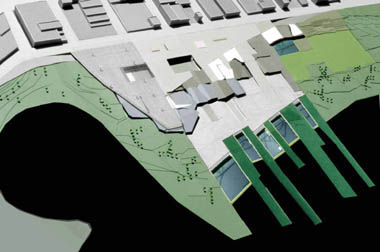
|
|
View of model |
R.A.N.T.
Residencies for the Application of New Technologies
Proposal for the East River Waterfront, Brooklyn
Competition entry, 1998
R.A.N.T. is a resource facility with a
residency program which provides space and equipment to a variety of users who wish to experiment with
new media and related communications technology. The equipment and user list is
open-ended, reflecting the transient nature of technology and how it is deeply affecting all forms of
cultural production.
Historically, the waterfront has been the site of confrontation between the natural and the man-made.
It is here that the irregularity of geography most abruptly meets the regularity of the city, and it
is here that the delivery and production processes of goods were sited to be prepared for distribution
and eventual consumption. Due to changing economic and cultural conditions, the character of this confrontation
has changed. No longer dependent on the river as the primary conduit of delivery for industry, the waterfront has
abandoned its special relationship with it altogether and is now becoming the favored site of nostalgia, where
many contemporary cities attempt to recuperate a lost past carefully linked to thematically corresponding leisure
activities. R.A.N.T. rejects this trend and attempts to reinvigorate the waterfront both through its program and its
architecture.
The formation of R.A.N.T. is based on how it would be used. Invoking the chaotic orbits of the three-body problem, three user
groups are assumed to occupy R.A.N.T. at any given time. Each group is assumed to desire a range of spatial types, from
regular to irregular in form, from open to closed in program. Each group first produces a geometric field spread out
across the site. This field is influenced by the initial smearing of the waterfront topography into the urban grid.
A chain for each user is created by connecting a distribution of cells in its geometric field. These three user chains
are then combined and allowed to overlap, resulting in a specific distribution of regular and irregular, open and closed
spaces. Models are used to develop the spatial and formal qualities of the user chain combinations. These models begin
to suggest possible ways to organize circulation and programmatic elements. R.A.N.T. utilizes a multi-dimensional tiling
system (named after the 19th Century Russian mathematician Georgii F. Voronoi) to negotiate the interface between the
regularity of the city plan and the irregularity of the waterfront. By extending the Voronoi concept to an
architectural field, an efficient and agile way to distribute matter across the site is created. Thin sheets of
matter at the boundary of huge voids- the typical result of a Voronoi tiling process- make themselves eligible for
structural, mechanical and circulation elements. As a result of this process, R.A.N.T. engineers a diversity of spatial
possibilities. Form is what is used to articulate and register these differences.
The eventual topography of R.A.N.T. becomes an extension of both the city and waterfront geography, smearing
them both together to create a new topographical formation. This formation links the city to the waterfront
as one traverses its surface, becoming a continuous public open space all the way to the river's edge. The interior of
R.A.N.T. is accessed by slipping through the topographical levels themselves, between the "regular" topography
of the city advancing toward the river, and the topography of landscape advancing in the opposite direction
from the waterfont toward the city. The boundary between landscape and building dissolves, making it difficult
to say when one begins and the other ends.

|
|
View of model |